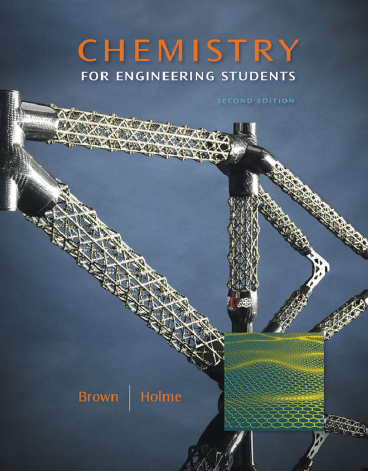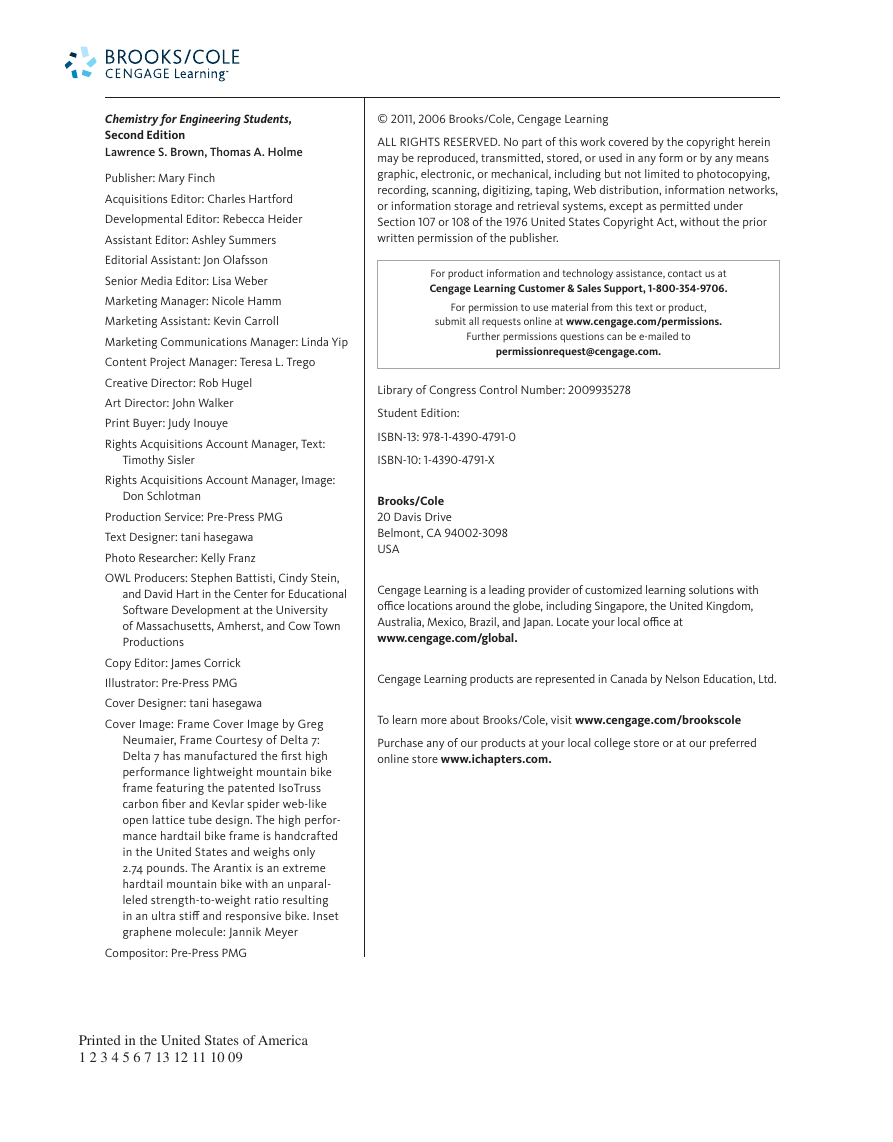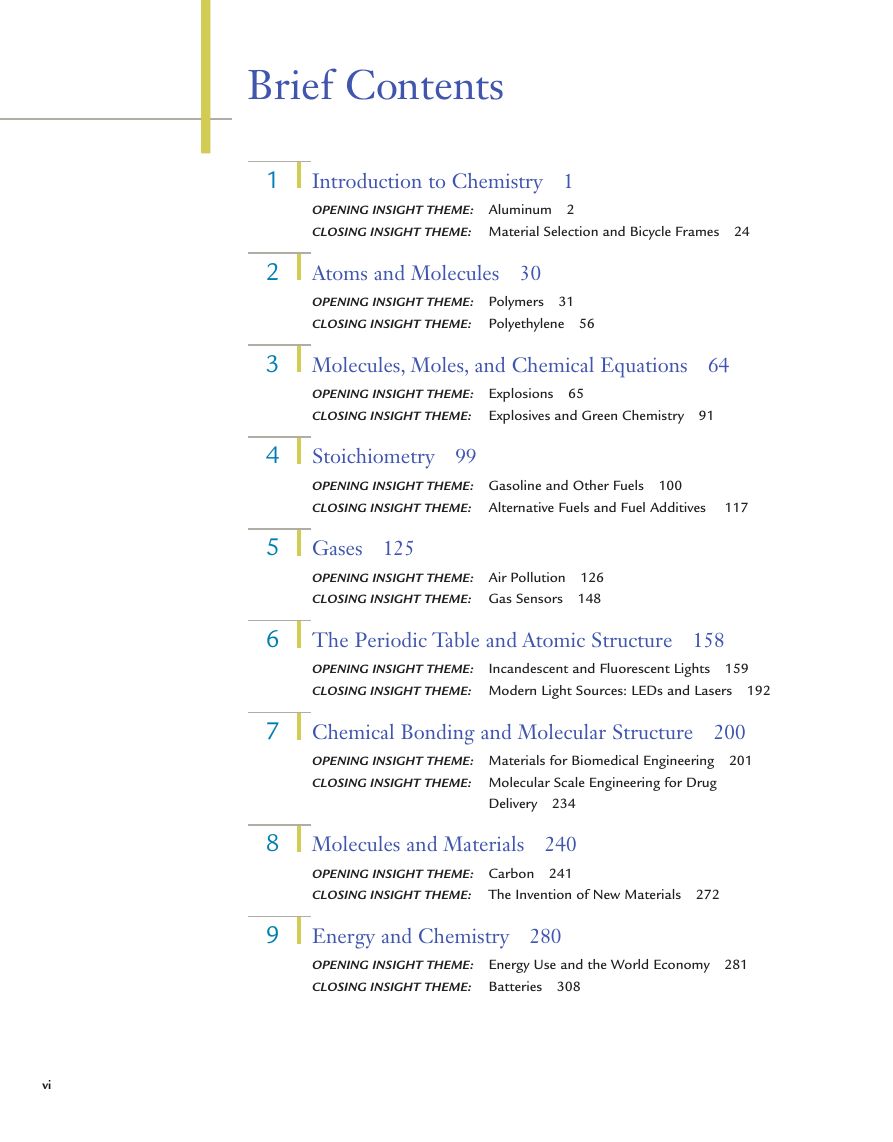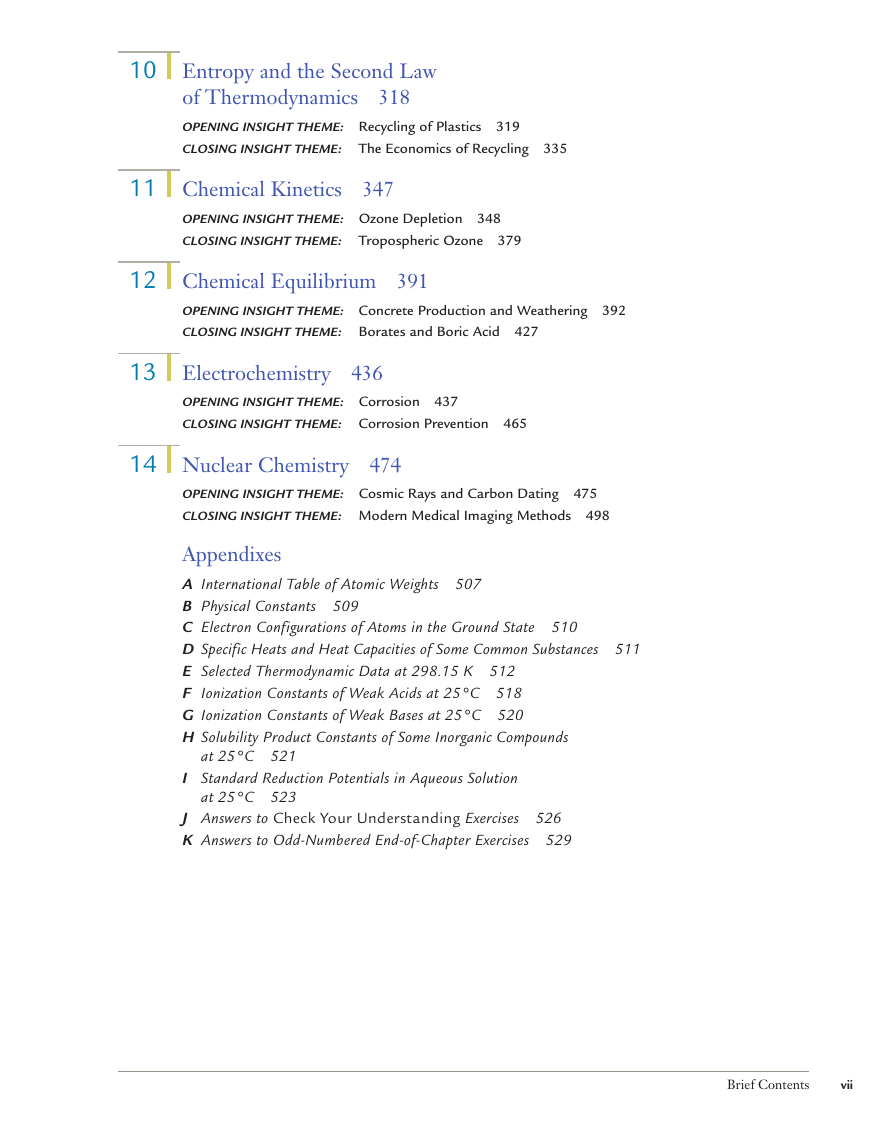Front Cover
Title Page
Copyright
Contents
Preface
Student Introduction
1: Introduction to Chemistry
1.1 Insight Into: Aluminum
1.2 The Study of Chemistry
The Macroscopic Perspective
The Microscopic or Particulate Perspective
Symbolic Representation
1.3 The Science of Chemistry: Observations and Models
Observations in Science
Interpreting Observations
Models in Science
1.4 Numbers and Measurements in Chemistry
Units
Numbers and Significant Figures
1.5 Problem Solving in Chemistry and Engineering
Using Ratios
Ratios in Chemistry Calculations
Conceptual Chemistry Problems
Visualization in Chemistry
1.6 Insight Into: Material Selection and Bicycle Frames
Bicycle Frames
Focus On Problem Solving
Summary
Key Terms
Problems And Exercises
2: Atoms and Molecules
2.1 Insight Into: Polymers
2.2 Atomic Structure and Mass
Fundamental Concepts of the Atom
Atomic Number and Mass Number
Isotopes
Atomic Symbols
Atomic Masses
2.3 Ions
Mathematical Description
Ions and Their Properties
2.4 Compounds and Chemical Bonds
Chemical Formulas
Chemical Bonding
2.5 The Periodic Table
Periods and Groups
Metals, Nonmetals, and Metalloids
2.6 Inorganic and Organic Chemistry
Inorganic Chemistry—Main Groups and Transition Metals
Organic Chemistry
Functional Groups
2.7 Chemical Nomenclature
Binary Systems
Naming Covalent Compounds
Naming Ionic Compounds
2.8 Insight Into: Polyethylene
Focus On Problem Solving
Summary
Key Terms
Problems And Exercises
3: Molecules, Moles, and Chemical Equations
3.1 Insight Into: Explosions
3.2 Chemical Formulas and Equations
Writing Chemical Equations
Balancing Chemical Equations
3.3 Aqueous Solutions and Net Ionic Equations
Solutions, Solvents, and Solutes
Chemical Equations for Aqueous Reactions
Acid–Base Reactions
3.4 Interpreting Equations and the Mole
Interpreting Chemical Equations
Avogadro’s Number and the Mole
Determining Molar Mass
3.5 Calculations Using Moles and Molar Masses
Elemental Analysis: Determining Empirical and Molecular Formulas
Molarity
Dilution
3.6 Insight Into: Explosives and Green Chemistry
Focus On Problem Solving
Summary
Key Terms
Problems And Exercises
4: Stoichiometry
4.1 Insight Into: Gasoline and Other Fuels
4.2 Fundamentals of Stoichiometry
Obtaining Ratios from a Balanced Chemical Equation
4.3 Limiting Reactants
4.4 Theoretical and Percentage Yields
4.5 Solution Stoichiometry
4.6 Insight Into: Alternative Fuels and Fuel Additives
Additives
Focus On Problem Solving
Summary
Key Terms
Problems And Exercises
5: Gases
5.1 Insight Into: Air Pollution
Properties of Gases
5.2 Pressure
Measuring Pressure
Units of Pressure
5.3 History and Application of the Gas Law
Units and the Ideal Gas Law
5.4 Partial Pressure
5.5 Stoichiometry of Reactions Involving Gases
STP Conditions
5.6 Kinetic–Molecular Theory and Ideal Versus Real Gases
Postulates of the Model
Real Gases and Limitations of the Kinetic Theory
Correcting the Ideal Gas Equation
5.7 Insight Into: Gas Sensors
Capacitance Manometer
Thermocouple Gauge
Ionization Gauge
Mass Spectrometer
Focus On Problem Solving
Summary
Key Terms
Problems And Exercises
6: The Periodic Table and Atomic Structure
6.1 Insight Into: Incandescent and Fluorescent Lights
6.2 The Electromagnetic Spectrum
The Wave Nature of Light
The Particulate Nature of Light
6.3 Atomic Spectra
The Bohr Atom
6.4 The Quantum Mechanical Model of the Atom
Potential Energy and Orbitals
Quantum Numbers
Visualizing Orbitals
6.5 The Pauli Exclusion Principle and Electron Configurations
Orbital Energies and Electron Configurations
Hund’s Rule and the Aufbau Principle
6.6 The Periodic Table and Electron Configurations
6.7 Periodic Trends in Atomic Properties
Atomic Size
Ionization Energy
Electron Affinity
6.8 Insight Into: Modern Light Sources: LEDs and Lasers
Focus On Problem Solving
Summary
Key Terms
Problems And Exercises
7: Chemical Bonding and Molecular Structure
7.1 Insight Into: Materials for Biomedical Engineering
7.2 The Ionic Bond
Formation of Cations
Formation of Anions
7.3 The Covalent Bond
Chemical Bonds and Energy
Chemical Bonds and Reactions
Chemical Bonds and the Structure of Molecules
7.4 Electronegativity and Bond Polarity
Electronegativity
Bond Polarity
7.5 Keeping Track of Bonding: Lewis Structures
Resonance
7.6 Orbital Overlap and Chemical Bonding
7.7 Hybrid Orbitals
7.8 Shapes of Molecules
7.9 Insight Into: Molecular Scale Engineering for Drug Delivery
Focus On Problem Solving
Summary
Key Terms
Problems And Exercises
8: Molecules and Materials
8.1 Insight Into: Carbon
8.2 Condensed Phases—Solids
8.3 Bonding in Solids: Metals, Insulators, and Semiconductors
Models of Metallic Bonding
Band Theory and Conductivity
Semiconductors
8.4 Intermolecular Forces
Forces Between Molecules
Dispersion Forces
Dipole–Dipole Forces
Hydrogen Bonding
8.5 Condensed Phases—Liquids
Vapor Pressure
Boiling Point
Surface Tension
8.6 Polymers
Addition Polymers
Condensation Polymers
copolymers
Physical Properties
Polymers and Additives
8.7 Insight Into: The Invention of New Materials
Focus On Problem Solving
Summary
Key Terms
Problems And Exercises
9: Energy and Chemistry
9.1 Insight Into: Energy Use and the World Economy
9.2 Defining Energy
Forms of Energy
Heat and Work
Energy Units
9.3 Energy Transformation and Conservation of Energy
Waste Energy
9.4 Heat Capacity and Calorimetry
Heat Capacity and Specific Heat
Calorimetry
9.5 Enthalpy
Defining Enthalpy
DH of Phase Changes
Vaporization and Electricity Production
Heat of Reaction
Bonds and Energy
Heats of Reaction for Some Specific Reactions
9.6 Hess’s Law and Heats of Reaction
Hess’s Law
Formation Reactions and Hess’s Law
9.7 Energy and Stoichiometry
Energy Density and Fuels
9.8 Insight Into: Batteries
Focus On Problem Solving
Summary
Key Terms
Problems And Exercises
10: Entropy and the Second Law of Thermodynamics
10.1 Insight Into: Recycling of Plastics
10.2 Spontaneity
Nature’s Arrow
Spontaneous Processes
Enthalpy and Spontaneity
10.3 Entropy
Probability and Spontaneous Change
Definition of Entropy
Judging Entropy Changes in Processes
10.4 The Second Law of Thermodynamics
The Second Law
Implications and Applications
10.5 The Third Law of Thermodynamics
10.6 Gibbs Free Energy
Free Energy and Spontaneous Change
Free Energy and Work
10.7 Free Energy and Chemical Reactions
Implications of DG° for a Reaction
10.8 Insight Into: The Economics of Recycling
Focus On Problem Solving
Summary
Key Terms
Problems And Exercises
11: Chemical Kinetics
11.1 Insight Into: Ozone Depletion
11.2 Rates of Chemical Reactions
Concept of Rate and Rates of Reaction
Stoichiometry and Rate
Average Rate and Instantaneous Rate
11.3 Rate Laws and the Concentration Dependence of Rates
The Rate Law
Determination of the Rate Law
11.4 Integrated Rate Laws
Zero-Order Integrated Rate Law
First-Order Integrated Rate Law
Second-Order Integrated Rate Law
Half-Life
11.5 Temperature and Kinetics
Temperature Effects and Molecules That React
Arrhenius Behavior
11.6 Reaction Mechanisms
Elementary Steps and Reaction Mechanisms
Mechanisms and Rate: The Rate-Determining Step
11.7 Catalysis
Homogeneous and Heterogeneous Catalysts
Molecular Perspective of Catalysis
Catalysis and Process Engineering
11.8 Insight Into: Tropospheric Ozone
Focus On Problem Solving
Summary
Key Terms
Problems And Exercises
12: Chemical Equilibrium
12.1 Insight Into: Concrete Production and Weathering
12.2 Chemical Equilibrium
Forward and Reverse Reactions
Mathematical Relationships
12.3 Equilibrium Constants
The Equilibrium (Mass Action) Expression
Gas Phase Equilibria: Kp vs. Kc
Homogeneous and Heterogeneous Equilibria
Numerical Importance of the Equilibrium Expression
Mathematical Manipulation of Equilibrium Constants
Reversing the Chemical Equation
Adjusting the Stoichiometry of the Chemical Reaction
Equilibrium Constants for a Series of Reactions
Units and the Equilibrium Constant
12.4 Equilibrium Concentrations
Equilibrium Concentrations from Initial Concentrations
Mathematical Techniques for Equilibrium Calculations
12.5 LeChatelier’s Principle
Effect of a Change in Concentration of Reactant or Product on Equilibrium
Effect of a Change in Pressure on Equilibrium When Gases Are Present
Effect of a Change in Temperature on Equilibrium
Effect of a Catalyst on Equilibrium
12.6 Solubility Equilibria
Solubility Product Constant
Defining the Solubility Product Constant
The Relationship Between Ksp and Molar Solubility
Common Ion Effect
Reliability of Using Molar Concentrations
12.7 Acids and Bases
The Brønsted–Lowry Theory of Acids and Bases
The Role of Water in the Brønsted–Lowry Theory
Weak Acids and Bases
12.8 Free Energy and Chemical Equilibrium
Graphical Perspective
Free Energy and Nonstandard Conditions
12.9 Insight Into: Borates and Boric Acid
Focus On Problem Solving
Summary
Key Terms
Problems And Exercises
13: Electrochemistry
13.1 Insight Into: Corrosion
13.2 Oxidation–Reduction Reactions and Galvanic Cells
Oxidation–Reduction and Half-Reactions
Building a Galvanic Cell
Terminology for Galvanic Cells
Atomic Perspective on Galvanic Cells
Galvanic Corrosion and Uniform Corrosion
13.3 Cell Potentials
Measuring Cell Potential
Standard Reduction Potentials
Nonstandard Conditions
13.4 Cell Potentials and Equilibrium
Cell Potentials and Free Energy
Equilibrium Constants
13.5 Batteries
Primary Cells
Secondary Cells
Fuel Cells
Limitations of Batteries
13.6 Electrolysis
Electrolysis and Polarity
Passive Electrolysis in Refining Aluminum
Active Electrolysis and Electroplating
13.7 Electrolysis and Stoichiometry
Current and Charge
Calculations Using Masses of Substances in Electrolysis
13.8 Insight Into: Corrosion Prevention
Coatings
Cathodic Protection
Preventing Corrosion in Space
Focus On Problem Solving
Summary
Key Terms
Problems And Exercises
14: Nuclear Chemistry
14.1 Insight Into: Cosmic Rays and Carbon Dating
14.2 Radioactivity and Nuclear Reactions
Radioactive Decay
Alpha Decay
Beta Decay
Gamma Decay
Electron Capture
Positron Emission
14.3 Kinetics of Radioactive Decay
Radiocarbon Dating
14.4 Nuclear Stability
14.5 Energetics of Nuclear Reactions
Binding Energy
Magic Numbers and Nuclear Shells
14.6 Transmutation, Fission, and Fusion
Transmutation: Changing One Nucleus into Another
Fission
Nuclear Reactors
Nuclear Waste
Fusion
14.7 The Interaction of Radiation and Matter
Ionizing and Penetrating Power of Radiation
Methods of Detecting Radiation
Measuring Radiation Dose
14.8 Insight Into: Modern Medical Imaging Methods
Focus On Problem Solving
Summary
Key Terms
Problems And Exercises
Appendixes
A: International Table Of Atomic Weights
B: Physical Constants
C: Electron Configurations Of Atoms In The Ground State
D: Specific Heats And Heat Capacities Of Some Common Substances
E: Selected Thermodynamic Data At 298.15 K
F: Ionization Constants Of Weak Acids At 25°C
G: Ionization Constants Of Weak Bases At 25°C
H: Solubility Product Constants Of Some Inorganic Compounds At 25°C
I: Standard Reduction Potentials In Aqueous Solution At 25°C
J: Answers To Check Your Understanding Exercises
K: Answers To Odd-Numbered End-Of-Chapter Exercises
Glossary
Index
















 2023年江西萍乡中考道德与法治真题及答案.doc
2023年江西萍乡中考道德与法治真题及答案.doc 2012年重庆南川中考生物真题及答案.doc
2012年重庆南川中考生物真题及答案.doc 2013年江西师范大学地理学综合及文艺理论基础考研真题.doc
2013年江西师范大学地理学综合及文艺理论基础考研真题.doc 2020年四川甘孜小升初语文真题及答案I卷.doc
2020年四川甘孜小升初语文真题及答案I卷.doc 2020年注册岩土工程师专业基础考试真题及答案.doc
2020年注册岩土工程师专业基础考试真题及答案.doc 2023-2024学年福建省厦门市九年级上学期数学月考试题及答案.doc
2023-2024学年福建省厦门市九年级上学期数学月考试题及答案.doc 2021-2022学年辽宁省沈阳市大东区九年级上学期语文期末试题及答案.doc
2021-2022学年辽宁省沈阳市大东区九年级上学期语文期末试题及答案.doc 2022-2023学年北京东城区初三第一学期物理期末试卷及答案.doc
2022-2023学年北京东城区初三第一学期物理期末试卷及答案.doc 2018上半年江西教师资格初中地理学科知识与教学能力真题及答案.doc
2018上半年江西教师资格初中地理学科知识与教学能力真题及答案.doc 2012年河北国家公务员申论考试真题及答案-省级.doc
2012年河北国家公务员申论考试真题及答案-省级.doc 2020-2021学年江苏省扬州市江都区邵樊片九年级上学期数学第一次质量检测试题及答案.doc
2020-2021学年江苏省扬州市江都区邵樊片九年级上学期数学第一次质量检测试题及答案.doc 2022下半年黑龙江教师资格证中学综合素质真题及答案.doc
2022下半年黑龙江教师资格证中学综合素质真题及答案.doc